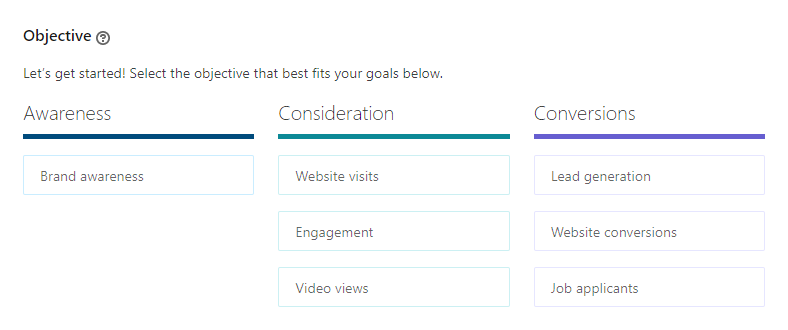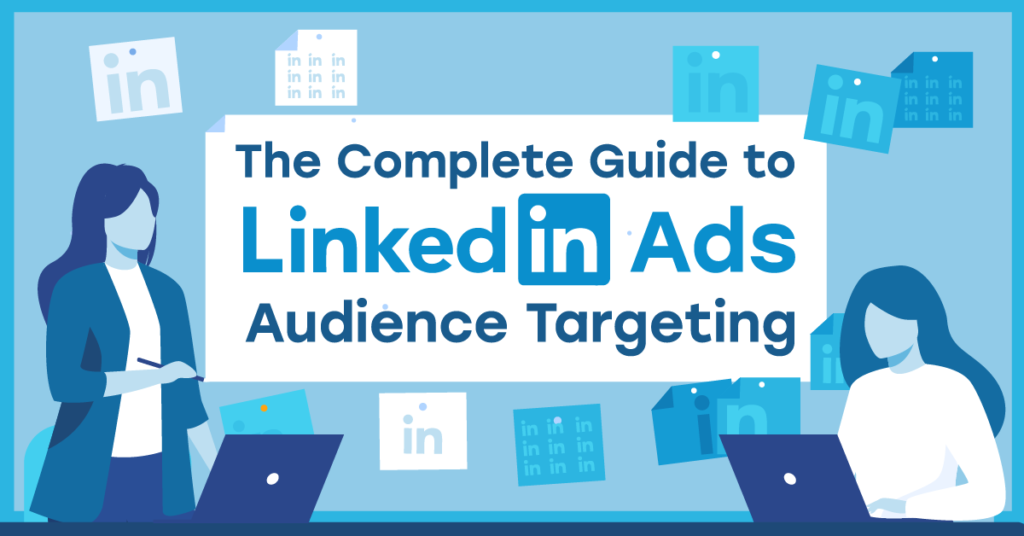Understanding how to find your ideal prospects is becoming a staple part of almost every marketing campaign.
And if you are a B2B SaaS company looking to acquire new customers it’s likely that your target prospect is on LinkedIn.
LinkedIn Ads are one of the most effective and immediate ways to generate qualified B2B opportunities.
In this post, we’ll share with you everything you need to know about finding your audience using LinkedIn Ads.
Let’s jump right in…
Choose Your Objective
Before diving into how to find your ideal prospects you must decide what action you want them to take when they see your ads.
Choosing an objective helps you customize your campaign creation, deliver the best ROI for your stated goal, and show you relevant reporting.

There are seven Campaign Objective choices:
Awareness
Objectives that generate interest in your product or service.
Choose Brand awareness if you want more people to learn about your product, services, or company.
With this objective, the algorithm will try to show your ad as many times as possible for the lowest price possible.
Consideration
Objectives that get people to start thinking about your business and look for more information about it:
- Website visits: Choose to drive traffic to your website or landing pages.
- Engagement: Choose to increase social media engagement and/or increase followers to your company page.
- Video views: Choose to share your videos with more people.
Conversions
Objectives that get people to take a specific action such as completing a form:
- Lead generation: Choose to capture leads on LinkedIn. You can use a lead generation form pre-filled with LinkedIn profile data.
- Website conversions: Choose to get more purchases, registrations, or downloads on your website.
- Job applicants: Choose to promote job opportunities at your company.
Create Your LinkedIn Audience Targeting
Now let’s cover all the different targeting options you have available inside LinkedIn’s campaign manager.
Here’s an infographic that summarizes all the targeting options. Or if you scroll down below the infographic, you can find more descriptions about all your options.

Locations
The first step in finding your prospects is specifying the country, state, city, or town where they are located.
This option allows you to target people based on where they live or visit by searching for locations.
You can also exclude locations where you don’t want your ad to be shown.
Selecting a location to show your ads to is a required targeting option.

Language
Target prospects based on the language they speak.
This step is very important as you won’t be able to make any changes once the campaign configuration is saved.
Also, English may be selected as the default language, even in areas where a local language is available, to reach all users in the region.

Audience attributes
Once you have selected the location and language of your prospects, it’s time to dive deeper into your LinkedIn ad targeting.
Audience attributes allow you to select from multiple criteria such as Company, Demographics, Education, etc. in order to find your ideal prospects:

LinkedIn Company Tareting
You can reach prospects based on the companies they’ve listed on their LinkedIn profile.
Company Connections
Target the 1st-degree connections of all employees at companies you select. This one is only available for companies with more than 500 employees.
Company Industry
Target prospects based on the primary industry of the company where they are employed.
(check out this infographic we created to see every single option available)
Company Size
Target prospects based on the size of the organization where they are employed.
- Self-employed
- 1-10 employees
- 11-50 employees
- 51-200 employees
- 201-500 employees
- 501-1000 employees
- 1001-5000 employees
- 5001-10,000 employees
- 10,001+ employees
Company Name
Target prospects based on the name of the company they’ve listed as his or her employer.
You can target both past employees or current employees of the company.
Company Followers
Allows you to target the followers of your Company Pages.
Your Ads account must be associated with your LinkedIn Company Page.
Company Growth Rate
Allows you to target companies by their rate of growth year over year.
Company Category
Allows you to target companies by custom segments such as such as S&P 500.
Demographics
You can reach prospects based on the age or gender they have listed on their profile.
Member age
Target prospects based on their estimated age range (based on their profile information)
- 18-24
- 25-34
- 35-54
- 55+
Member Gender
Target prospects based on their inferred gender.
- All
- Male
- Female
Education
You can reach prospects based on a degree, field of study, or learning institution where they completed a course.
Fields of study
Target prospects within a major area of study. For example, biotechnology or marketing.
Degree
Target prospects who have completed a specific degree recognized by a college, university, or other learning institution.
- PhD
- Master of
- Bachelor
- Associate
- Science
Member Schools
Target prospects based on specific schools, colleges, universities, or other learning institutions attended.
Job Experience
You can reach prospects based on their job experience, skills or years of experience.
Job Experience is one of the most powerful criteria on LinkedIn. No other social platform can get that specific. Facebook, Twitter, and Instagram don’t have half the professional data that LinkedIn has!
Job Function
Target prospects based on standardized groupings of the job titles entered by LinkedIn members.
Job Function is is an attribute whose database is only known to LinkedIn.
This is also one of the most commonly used ad targeting criteria and as such it can also be one of the most expensive.
Job Seniority
Target prospects based on their rank and influence in the organization where they are employed.
- Unpaid
- Training
- Entry
- Senior
- Manager
- Director
- VP
- CXO
- Owner
- Partner
Job Title
Target prospects based on their position within their organization. There are 380+ different job titles you can target to find your ideal prospects.
You can target by current job titles, past job titles, or both.
Member Skills
Target prospects based on the skills they include in the Skills & Endorsements section on their profile.
Years Of Experience
Target prospects based on how much professional experience they’ve accumulated over their career.
- Doesn’t include gaps in employment
- Overlapping positions don’t count twice
Interests & Traits
You can reach prospects based on the content they share and engage with on LinkedIn, topics they follow, or professional groups they may belong to.
Member Groups
Target prospects who share interests, traits, or professional associations by belonging to the same LinkedIn Group.
Member Interests
Target prospects based on their interests that align with your business.
For example:
- Arts and Entertainment
- Business and Management
- Careers and Employment
- Finance and Economy
- Health
- Marketing and Advertising
- Politics and Law
- Sales and Retail
- Science and Environment
- Society and Culture
- Technology
Member Traits
Target prospects based on traits and behaviors, for example, members who are frequent travelers, desktop users, or job seekers and many more.
Audience Templates
You can also select from LinkedIn’s audience templates, which are templates pre-populated with various targeting options to help you reach desired audiences more easily and efficiently.
- Members with a Bachelor’s Degree
- Expertise in Biotechnology
- Expertise in Bitcoin / Blockchain
- Expertise in Computer Science
- Corporate HR Professionals
- Customer Experience Professionals
- Expertise in Development Operations
- Expertise in Enterprise Resource Planning (ERP)
- Event Planners
- Financial Advisors
- Financial Decision Maker
- Information Security Professionals
- Expertise in Internet of Things (IoT)
- IT Decision Makers
- Logistics and Supply Chain Professionals
- Marketing Professionals
- Members with a Master’s Degree
- Medical Doctors
- Mortgage Professionals
- New to Job Market
- Nurses
- Members with a PhD Degree
- Software Engineer Professionals
- Procurement Professionals
- Small Business Owners
- Expertise in Telecom
Matched Audiences
Matched audiences allow you to use your data to reach prospects who have already interacted with your brand, and new prospects who are similar to those. This user data can be collected via pixel or uploaded data files.
Website Visits
Create an audience based on your website visitors to deliver relevant ad content based on the pages they visited on your site. Website visitor audiences are created by using the LinkedIn pixel on your website.
Video Viewers
Reach prospects who viewed almost all or part of your LinkedIn video ads. Create audiences based on the percentage length of the video watched and retarget them.
- 25%
- 50%
- 75%
- 97%
- 100%
- You can also choose a time period of 30-365 days in the past.
Lead Form Engagement
Allows you to retarget prospects who have previously opened or submitted one of your Lead Gen Forms.
Company Targeting
Upload CSV lists of company names, company domains, LinkedIn Page URLs, and more to match against LinkedIn Pages.
Contact Targeting
Upload lists of personal and professional email addresses, first and last names, or Google or Apple Mobile IDs to match against LinkedIn members.
Lookalikes
Combine LinkedIn’s powerful professional data with an existing matched audience to identify new audience segments similar to your existing customers, website visitors, and target accounts.
Audiences Size
As you select your targeting options, LinkedIn will show you an estimate of the audience size you’ll be able to reach. The minimum audience size required to run an advertising campaign is 300 members.

If your targeting selections severely limit your reach, you will be notified with an Audience Too Narrow message which prevents you from saving your targeting and moving to the next step.
Over to you
Thanks for reading! I hope you find it to be a useful guide for using LinkedIn Ads to find your target audience.
I’d love to continue the conversation with you in the comments below. What has been the best success you’ve found with LinkedIn Ads? What are your top tips for B2B SaaS lead generation?


Thank you so much, your post’s so interesting, detail and helpful